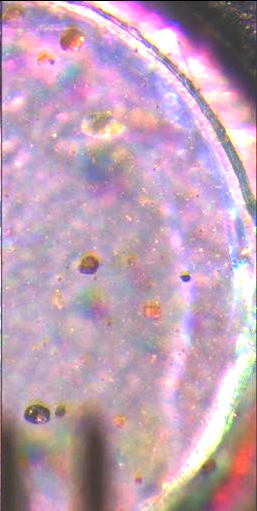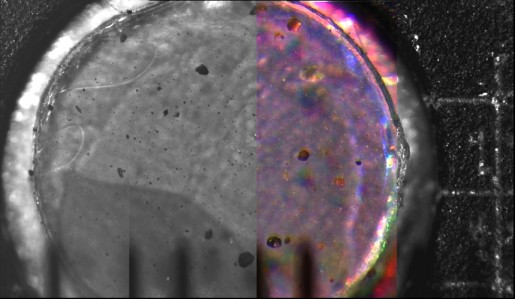“To see a world in a grain of sand…” – English Poet William Blake
The Phoenix science team tested out the lander’s Optical Microscope by imaging grains of sand and dust particles, some as small as one-tenth the diameter of a human hair. These are the highest resolution image ever of small soil particles from another planet. “We have images showing the diversity of mineralogy on Mars at a scale that is unprecedented in planetary exploration,” said Michael Hecht of NASA’s Jet Propulsion Laboratory.
The microscope observed particles that had fallen onto an exposed surface of the lander. “It’s a first quick look,” Hecht said. “This experiment was partly an insurance policy for something to observe with the microscope before getting a soil sample delivered by the arm, and partly a characterization of the Optical Microscope. All the tools are working well.”
However, some of the particles may be “alien” – that is, they might have come from inside the spacecraft when Phoenix dropped to Mars surface at landing. But at first glance, many of these grains match expectations for Martian particles. “We will be using future observations of soil samples delivered by the Robotic Arm to confirm whether the types of particles in this dustfall sample are also seen in samples we can be certain are Martian in origin,” Hecht said.
The particles show a range of shapes and colors.
“You can see the amount of variety there is in what appears otherwise to be just reddish brown soil,” said Tom Pike, Phoenix science team member from Imperial College London. He noted that one translucent particle resembles a grain of salt, but that it is too early to say for sure.
Meanwhile, Phoenix received commands Thursday to collect its first soil sample to be delivered to its science lab instrument on the lander deck. Those commands were originally sent on Wednesday, but the lander didn’t receive them as the relay for the commands, the Mars Odyssey, had gone into safe mode. The orbiter may have been hit by a cosmic ray, and engineers from JPL say nominal operations of the spacecraft should return by the end of the week. This type of event has occurred a couple of times in the Odyssey mission, and engineers don’t appear overly concerned about the situation.
So, the commands were successfully re-sent via the Mars Reconnaissance Orbiter. Look for the first science results from Phoenix within the next day or so.
Original News Source: Phoenix news release



good job covering the phoenix mission UT!!!
Too bad the little alien forgot to get his fingers out of the picture.
Exciting, thanks for the continued updates Nancy
I have to wonder, though: does NASA have plans to check their samples before they heat them to check their composition?
I mean, how bad would it be to go looking for signs that Mars can or once could support life only to dig some up and fry it?
such an impressive mission-in-progress. It’s still hard to imagine that we are sending commands to the lander at this distance.
It is really good to have that microscope on the Phoenix lander: It helps to check the samples the lander takes for contamination of these samples.
There seems to be a fibre in the upper left corner of the picture, this fibre obviously came from Earth with the lander. If heated in the lander´s oven together with a sample of the martian soil , it would melt and go up in steam. Thus, the mass spectrometer on board measuring the composition of the gases that are emanating from the heated sample would reveal the existence of organic compounds on Mars that might be similar to molecules which on earth we know to form polymeres. This might lead some to the idea that there must be some type of plastic-producing bacteria thriving in the Martian soil …
Now we are well able to evaluate the results we will get from Phoenix. I am looking forward for them. This is a great craft!
Regards,
Günther
Breathtaking and incredible. For some reason this picture makes me unbelievably happy to be living in the current times. Its as if this picture captures the magnitude and microcosm of Mars’ surface while, at the same time, it captures the fact that the macrocosm of the universe is separated simply by distances that have only to be overcome.
Thanks a lot, Nancy. These updates are always incredible.
I’m impressed. let’s see what they turn up in the days to come.
You know, the pictures are very suggestive of what may be a living organism.
Unlikely, since the translucent material appears to be solid. But nice spherical shape, an exterior membrane layer, organelles inside.
The conspiracy nuts will have a field day with these pictures for years to come.
Sorry, I didn’t read the story thoroughly enough before posting. The spherical translucent material is actually from the lander’s scientific equipment. So, just dust grains caught in the material.